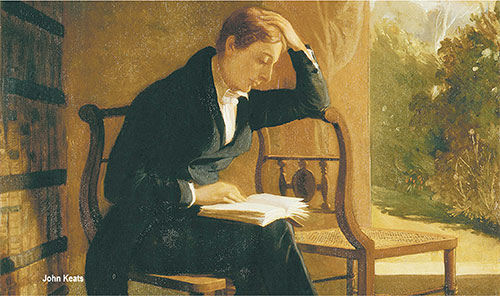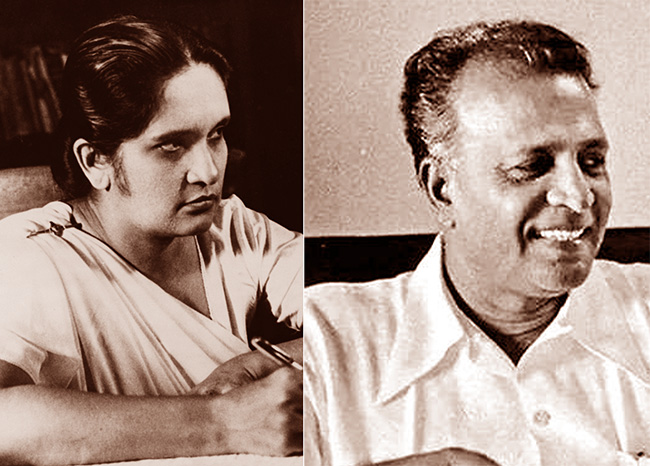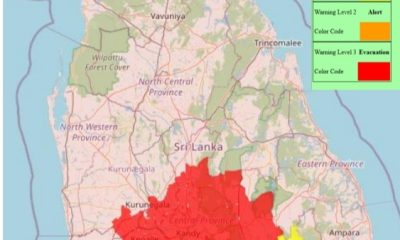Sat Mag
John Keats at 200

By Uditha Devapriya
The bicentenary of John Keats fell on Tuesday, February 23.
When I think of William Wordsworth and Samuel Taylor Coleridge today, what springs to my mind is how their politics reflected their poetry. Wordsworth was 19 and Coleridge 17 when the French Revolution broke out. It was in their youth, in other words, that France underwent the Fall of the Bastille and the execution of the king and queen. The youthful idealism that greeted the former event – so full of promise in its vision for the future – couldn’t survive the shock of the latter, after which the Revolution became a harsh political actuality that England and Europe had to contend with and combat against.
What happened to Wordsworth and Coleridge was tragic, but inevitable: lost in their youthful ardour over the Revolution, they regressed to jingoism and conservatism in later years. This was to be seen the most in Wordsworth: when in his early poems he could write of his sympathy for the downtrodden, in later years (particularly in the period in which he wrote “England”, “The Excursion” and the sonnets on the English Church) he went back on that sympathy. He was no longer contemplating on poverty and injustice as though they could be “resolved” by the overthrow of tyranny. He wrote of them as inevitable, as capable of resolution through an almost mystical tranquillity (“She sleeps in the calm earth, and peace is here”).
Contrast these two against Byron and Shelley (who were born after them), and you will realise how easy it is to categorise their poetry in the face of what happened in France. The latter two weren’t born during the Revolution. They were “children of the Revolution”, which meant that they didn’t take the usual route idealists took before recapitulating. In their hands, the personal was closely intertwined with the political. That led them to become heretics and rebels (“And tyrants and slaves are like shadows of night / In the van of the morning light”).
It’s difficult to compare John Keats with either of these poets, particularly when we consider that he was a contemporary of Byron and Shelley. Keats was the youngest in their generation (Shelley was his senior by three years). And yet, to my mind, Keat’s best poetry shares some affinity with that of Wordsworth, particularly in the latter’s idealisation of nature. Yet he shared none of his beliefs; in that sense he was more at home with Byron. I know that’s a bold claim to make, but make it I will.
I think John Keats’s great achievement as a poet is his intensely poignant vision of the world. That vision was never marred by political rhetoric. There’s no doubt that what comes out in his two poems on Leigh Hunt, for instance, is anger against his jailers. But look closer: far from using Hunt’s imprisonment to vent out frustration against the political order, what Keats achieves is something else:
Minion of grandeur! think you he did wait?
Think you he nought but prison walls did see,
Till, so unwilling, thou unturn’dst the key?
Ah, no! far happier, nobler was his fate!
Keats’s idealisation of Hunt here seems to me to undermine the reality of his imprisonment. A critic can argue this was in line with Hunt’s strength of will even while being punished — Jeremy Bentham found him playing battledore when visiting him in prison — but for me at least, it is not congruent with Keats’s elevation of that punishment as a sign of his maturity as a critic (“In Spenser’s hall he strayed, and bowers fair”). I may be wrong, but that is how I view his Leigh Hunt poems.
Notwithstanding that, however, Keats was without a doubt a nonconformist. He had a fairly liberal education. Nicholas Roe, in “Everyman’s” anthology of his poetry, has written that Enfield School, which the young Keats attended, was important for “transmitting to Keats the dynamic intellectual life of English dissent.” Roe does his best to overturn the popular view of him as an enigmatic romantic, a poet more concerned with beauty than with reality, and to his credit he does make a point when highlighting the allegory in “Hyperion: A Fragment.”
But what is it in “Hyperion” that merits such a point or comparison? To find out for myself I read it, and I came across these lines:
“Shut up your senses, stifle up your ears,
“My voice is not a bellows unto ire.
“Yet listen, ye who will, whilst I bring proof
“How ye, perforce, must be content to stoop:
“And in the proof much comfort will I give,
“If ye will take that comfort in its truth.
“We fall by course of Nature’s law, not force
“Of thunder, or of Jove.
The speaker of these lines is Oceanus, the God of the Sea. “Hyperion” (which Keats never completed) is about the overthrow of one order by another. The Titans are soothing their sorrow in the aftermath of their fall to the Olympians. Some of the Titans want to rebel, but Oceanus is the voice of reason here: not only must the old order pass to the new, but they must accept it as an eventuality. Roe must have seen in this an affirmation of revolution, especially at a time when portraying dethroned monarchs was “regarded in Britain as potentially an incitement to revolution.”
But I read these lines differently. “Nature’s law” presupposes a preconceived (and divinely ordained) history, a passage from the old to the new which maintains the same structure that sustained the old. Call it “parliamentary democracy”, call it a “coup”, to me the overthrow of the Titans was nothing more or less than a violent overthrow of one set of gods by another.
I am of course not suggesting that for Keats the most valid “overthrow of tyranny” was one which sustained the same political base (which by the way is what pretty much goes for democracy today!), but I do believe that Keats’s conception of history as an organic process of change followed by order is not in line with Roe’s reading of the poem. This is what imputes fresh nuances of meaning to Keats, and marks him out as probably the most idiosyncratic, atypical poet among the Romantics.
Not that he was an outsider to them. In his work we see that same Romantic idealisation of beauty and nature, because of which his poetry is often classed as “escapist.” That classification is crass, though. To consider Keats’s high regard for beauty (back when the chief quality of the Romantics was, yes, their high regard for beauty!) as “escapist” is to read his work wrongly. His masterpieces — which for me were his odes to such abstractions as Indolence, Beauty, Melancholy, and Art — are marked out well by the intermingling of substantive reality and aesthetic delight. It is here that his real genius is to be found, and not (as is claimed by critics who clamour to read the political in his poetry) in “Hyperion.”
Consider, for instance, these lines from “Ode to a Nightingale”
Fade far away, dissolve, and quite forget
What thou among the leaves hast never known,
The weariness, the fever, and the fret
Here, where men sit and hear each other groan;
Where palsy shakes a few, sad, last gray hairs,
Where youth grows pale, and spectre-thin, and dies;
Where but to think is to be full of sorrow
And leaden-eyed despairs,
Where Beauty cannot keep her lustrous eyes,
Or new Love pine at them beyond to-morrow.
Here’s the motif that defines the intensity of his poetry: his constant yearning for tranquillity and solace in the face of tragedy (his brother died of tuberculosis, and he himself would succumb to it at the age of 25). This is what critics class as “escapist” in terms of imagery — the juxtaposition of the “weariness” and “fever” of mortal man with the immortal song of the nightingale, as well as the mortality of Beauty in the face of human suffering — but I prefer to see them as the anguish of a heart beset with tragedy, a microcosm of the tragedy of the world.
But to consider this as his strength is to consider Keats’s defining marks — his use of pastoral imagery, metaphor, and personification — as leading to a never-ending search for tranquillity. Wordsworth never faced this problem, because in his later years he could (thanks to his politics) offer an easy way out: a contemplation of the mystical (which Regi Siriwardena called “inertia”). Wordsworth’s volte-face here is what I’d consider as “escapist”, and not Keats’s sustained quest for solace.
Keats weakened a little, in my opinion, when he deviated from his meditations on pain and pleasure. To be more specific, when the experience he brought out was inadequate when compared with the form. I can specifically think of one poem here, the first of his I ever learnt: “La Belle Dame Sans Merci.” What we relate to in that poem is the knight and his harrowing ordeal. But the quickness of that ordeal — which critics read as contributing to its shocking appeal — leads to disappointment. We know the woman isn’t who she is when we hear these lines:
And there she lulled me asleep,
And there I dream’d — Ah! woe betide!
The latest dream I ever dream’d
On the cold hill’s side.
I saw pale kings and princes too,
Pale warriors, death-pale were they all;
They cried — “La Belle Dame sans Merci
Hath thee in thrall!”
We’re made to believe that it is this sudden experience that frightens and turns him to despair, when in the next verse we are told that
I saw their starved lips in the gloam,
With horrid warning gaped wide,
And I awoke and found me here,
On the cold hill’s side.
But the suddenness of that experience (“And I awoke and found me here”) and the economy with which Keats relates it to the reader deprive the poem of any subtlety. Call me a cynic, but when I read these lines now, I can’t understand why the knight should be disappointed, whether at the woman’s transformation or at the fact that his love for her wasn’t returned. Keats’s use of imagery is sparse, almost austere, and that deprives it of vitality. I rate it personally among his weaker work.
I must confess that at the time I first read Keats I was an incurable romantic, and that is what endeared his poetry to me. 10 years later, I find that position unchanged: regardless of whatever beliefs he may have held on to, Keats is the poet we look to when beset with personal tragedy, not because contemplation affords escapism, but because in it we realise that suffering and mortality are eternal, and that the quest for eternal(ised) abstractions like beauty may never end.
The writer can be reached at udakdev1@gmail.com
Sat Mag
October 13 at the Women’s T20 World Cup: Injury concerns for Australia ahead of blockbuster game vs India

Australia vs India
Sharjah, 6pm local time
Australia have major injury concerns heading into the crucial clash. Just four balls into the match against Pakistan, Tayla Vlaeminck was out with a right shoulder dislocation. To make things worse, captain Alyssa Healy suffered an acute right foot injury while batting on 37 as she hobbled off the field with Australia needing 14 runs to win. Both players went for scans on Saturday.
India captain Harmanpreet Kaur who had hurt her neck in the match against Pakistan, turned up with a pain-relief patch on the right side of her neck during the Sri Lanka match. She also didn’t take the field during the chase. Fast bowler Pooja Vastrakar bowled full-tilt before the Sri Lanka game but didn’t play.
India will want a big win against Australia. If they win by more than 61 runs, they will move ahead of Australia, thereby automatically qualifying for the semi-final. In a case where India win by fewer than 60 runs, they will hope New Zealand win by a very small margin against Pakistan on Monday. For instance, if India make 150 against Australia and win by exactly 10 runs, New Zealand need to beat Pakistan by 28 runs defending 150 to go ahead of India’s NRR. If India lose to Australia by more than 17 runs while chasing a target of 151, then New Zealand’s NRR will be ahead of India, even if Pakistan beat New Zealand by just 1 run while defending 150.
Overall, India have won just eight out of 34 T20Is they’ve played against Australia. Two of those wins came in the group-stage games of previous T20 World Cups, in 2018 and 2020.
Australia squad:
Alyssa Healy (capt & wk), Darcie Brown, Ashleigh Gardner, Kim Garth, Grace Harris, Alana King, Phoebe Litchfield, Tahlia McGrath, Sophie Molineux, Beth Mooney, Ellyse Perry, Megan Schutt, Annabel Sutherland, Tayla Vlaeminck, Georgia Wareham
India squad:
Harmanpreet Kaur (capt), Smriti Mandhana (vice-capt), Yastika Bhatia (wk), Shafali Verma, Deepti Sharma, Jemimah Rodrigues, Richa Ghosh (wk), Pooja Vastrakar, Arundhati Reddy, Renuka Singh, D Hemalatha, Asha Sobhana, Radha Yadav, Shreyanka Patil, S Sajana
Tournament form guide:
Australia have three wins in three matches and are coming into this contest having comprehensively beaten Pakistan. With that win, they also all but sealed a semi-final spot thanks to their net run rate of 2.786. India have two wins in three games. In their previous match, they posted the highest total of the tournament so far – 172 for 3 and in return bundled Sri Lanka out for 90 to post their biggest win by runs at the T20 World Cup.
Players to watch:
Two of their best batters finding their form bodes well for India heading into the big game. Harmanpreet and Mandhana’s collaborative effort against Pakistan boosted India’s NRR with the semi-final race heating up. Mandhana, after a cautious start to her innings, changed gears and took on Sri Lanka’s spinners to make 50 off 38 balls. Harmanpreet, continuing from where she’d left against Pakistan, played a classic, hitting eight fours and a six on her way to a 27-ball 52. It was just what India needed to reinvigorate their T20 World Cup campaign.
[Cricinfo]
Sat Mag
Living building challenge

By Eng. Thushara Dissanayake
The primitive man lived in caves to get shelter from the weather. With the progression of human civilization, people wanted more sophisticated buildings to fulfill many other needs and were able to accomplish them with the help of advanced technologies. Security, privacy, storage, and living with comfort are the common requirements people expect today from residential buildings. In addition, different types of buildings are designed and constructed as public, commercial, industrial, and even cultural or religious with many advanced features and facilities to suit different requirements.
We are facing many environmental challenges today. The most severe of those is global warming which results in many negative impacts, like floods, droughts, strong winds, heatwaves, and sea level rise due to the melting of glaciers. We are experiencing many of those in addition to some local issues like environmental pollution. According to estimates buildings account for nearly 40% of all greenhouse gas emissions. In light of these issues, we have two options; we change or wait till the change comes to us. Waiting till the change come to us means that we do not care about our environment and as a result we would have to face disastrous consequences. Then how can we change in terms of building construction?
Before the green concept and green building practices come into play majority of buildings in Sri Lanka were designed and constructed just focusing on their intended functional requirements. Hence, it was much likely that the whole process of design, construction, and operation could have gone against nature unless done following specific regulations that would minimize negative environmental effects.
We can no longer proceed with the way we design our buildings which consumes a huge amount of material and non-renewable energy. We are very concerned about the food we eat and the things we consume. But we are not worrying about what is a building made of. If buildings are to become a part of our environment we have to design, build and operate them based on the same principles that govern the natural world. Eventually, it is not about the existence of the buildings, it is about us. In other words, our buildings should be a part of our natural environment.
The living building challenge is a remarkable design philosophy developed by American architect Jason F. McLennan the founder of the International Living Future Institute (ILFI). The International Living Future Institute is an environmental NGO committed to catalyzing the transformation toward communities that are socially just, culturally rich, and ecologically restorative. Accordingly, a living building must meet seven strict requirements, rather certifications, which are called the seven “petals” of the living building. They are Place, Water, Energy, Equity, Materials, Beauty, and Health & Happiness. Presently there are about 390 projects around the world that are being implemented according to Living Building certification guidelines. Let us see what these seven petals are.
Place
This is mainly about using the location wisely. Ample space is allocated to grow food. The location is easily accessible for pedestrians and those who use bicycles. The building maintains a healthy relationship with nature. The objective is to move away from commercial developments to eco-friendly developments where people can interact with nature.
Water
It is recommended to use potable water wisely, and manage stormwater and drainage. Hence, all the water needs are captured from precipitation or within the same system, where grey and black waters are purified on-site and reused.
Energy
Living buildings are energy efficient and produce renewable energy. They operate in a pollution-free manner without carbon emissions. They rely only on solar energy or any other renewable energy and hence there will be no energy bills.
Equity
What if a building can adhere to social values like equity and inclusiveness benefiting a wider community? Yes indeed, living buildings serve that end as well. The property blocks neither fresh air nor sunlight to other adjacent properties. In addition, the building does not block any natural water path and emits nothing harmful to its neighbors. On the human scale, the equity petal recognizes that developments should foster an equitable community regardless of an individual’s background, age, class, race, gender, or sexual orientation.
Materials
Materials are used without harming their sustainability. They are non-toxic and waste is minimized during the construction process. The hazardous materials traditionally used in building components like asbestos, PVC, cadmium, lead, mercury, and many others are avoided. In general, the living buildings will not consist of materials that could negatively impact human or ecological health.
Beauty
Our physical environments are not that friendly to us and sometimes seem to be inhumane. In contrast, a living building is biophilic (inspired by nature) with aesthetical designs that beautify the surrounding neighborhood. The beauty of nature is used to motivate people to protect and care for our environment by connecting people and nature.
Health & Happiness
The building has a good indoor and outdoor connection. It promotes the occupants’ physical and psychological health while causing no harm to the health issues of its neighbors. It consists of inviting stairways and is equipped with operable windows that provide ample natural daylight and ventilation. Indoor air quality is maintained at a satisfactory level and kitchen, bathrooms, and janitorial areas are provided with exhaust systems. Further, mechanisms placed in entrances prevent any materials carried inside from shoes.
The Bullitt Center building
Bullitt Center located in the middle of Seattle in the USA, is renowned as the world’s greenest commercial building and the first office building to earn Living Building certification. It is a six-story building with an area of 50,000 square feet. The area existed as a forest before the city was built. Hence, the Bullitt Center building has been designed to mimic the functions of a forest.
The energy needs of the building are purely powered by the solar system on the rooftop. Even though Seattle is relatively a cloudy city the Bullitt Center has been able to produce more energy than it needed becoming one of the “net positive” solar energy buildings in the world. The important point is that if a building is energy efficient only the area of the roof is sufficient to generate solar power to meet its energy requirement.
It is equipped with an automated window system that is able to control the inside temperature according to external weather conditions. In addition, a geothermal heat exchange system is available as the source of heating and cooling for the building. Heat pumps convey heat stored in the ground to warm the building in the winter. Similarly, heat from the building is conveyed into the ground during the summer.
The potable water needs of the building are achieved by treating rainwater. The grey water produced from the building is treated and re-used to feed rooftop gardens on the third floor. The black water doesn’t need a sewer connection as it is treated to a desirable level and sent to a nearby wetland while human biosolid is diverted to a composting system. Further, nearly two third of the rainwater collected from the roof is fed into the groundwater and the process resembles the hydrologic function of a forest.
It is encouraging to see that most of our large-scale buildings are designed and constructed incorporating green building concepts, which are mainly based on environmental sustainability. The living building challenge can be considered an extension of the green building concept. Amanda Sturgeon, the former CEO of the ILFI, has this to say in this regard. “Before we start a project trying to cram in every sustainable solution, why not take a step outside and just ask the question; what would nature do”?
Sat Mag
Something of a revolution: The LSSP’s “Great Betrayal” in retrospect

By Uditha Devapriya
On June 7, 1964, the Central Committee of the Lanka Sama Samaja Party convened a special conference at which three resolutions were presented. The first, moved by N. M. Perera, called for a coalition with the SLFP, inclusive of any ministerial portfolios. The second, led by the likes of Colvin R. de Silva, Leslie Goonewardena, and Bernard Soysa, advocated a line of critical support for the SLFP, but without entering into a coalition. The third, supported by the likes of Edmund Samarakkody and Bala Tampoe, rejected any form of compromise with the SLFP and argued that the LSSP should remain an independent party.
The conference was held a year after three parties – the LSSP, the Communist Party, and Philip Gunawardena’s Mahajana Eksath Peramuna – had founded a United Left Front. The ULF’s formation came in the wake of a spate of strikes against the Sirimavo Bandaranaike government. The previous year, the Ceylon Transport Board had waged a 17-day strike, and the harbour unions a 60-day strike. In 1963 a group of working-class organisations, calling itself the Joint Committee of Trade Unions, began mobilising itself. It soon came up with a common programme, and presented a list of 21 radical demands.
In response to these demands, Bandaranaike eventually supported a coalition arrangement with the left. In this she was opposed, not merely by the right-wing of her party, led by C. P. de Silva, but also those in left parties opposed to such an agreement, including Bala Tampoe and Edmund Samarakkody. Until then these parties had never seen the SLFP as a force to reckon with: Leslie Goonewardena, for instance, had characterised it as “a Centre Party with a programme of moderate reforms”, while Colvin R. de Silva had described it as “capitalist”, no different to the UNP and by default as bourgeois as the latter.
The LSSP’s decision to partner with the government had a great deal to do with its changing opinions about the SLFP. This, in turn, was influenced by developments abroad. In 1944, the Fourth International, which the LSSP had affiliated itself with in 1940 following its split with the Stalinist faction, appointed Michel Pablo as its International Secretary. After the end of the war, Pablo oversaw a shift in the Fourth International’s attitude to the Soviet states in Eastern Europe. More controversially, he began advocating a strategy of cooperation with mass organisations, regardless of their working-class or radical credentials.
Pablo argued that from an objective perspective, tensions between the US and the Soviet Union would lead to a “global civil war”, in which the Soviet Union would serve as a midwife for world socialist revolution. In such a situation the Fourth International would have to take sides. Here he advocated a strategy of entryism vis-à-vis Stalinist parties: since the conflict was between Stalinist and capitalist regimes, he reasoned, it made sense to see the former as allies. Such a strategy would, in his opinion, lead to “integration” into a mass movement, enabling the latter to rise to the level of a revolutionary movement.

Though controversial, Pablo’s line is best seen in the context of his times. The resurgence of capitalism after the war, and the boom in commodity prices, had a profound impact on the course of socialist politics in the Third World. The stunted nature of the bourgeoisie in these societies had forced left parties to look for alternatives. For a while, Trotsky had been their guide: in colonial and semi-colonial societies, he had noted, only the working class could be expected to see through a revolution. This entailed the establishment of workers’ states, but only those arising from a proletarian revolution: a proposition which, logically, excluded any compromise with non-radical “alternatives” to the bourgeoisie.
To be sure, the Pabloites did not waver in their support for workers’ states. However, they questioned whether such states could arise only from a proletarian revolution. For obvious reasons, their reasoning had great relevance for Trotskyite parties in the Third World. The LSSP’s response to them showed this well: while rejecting any alliance with Stalinist parties, the LSSP sympathised with the Pabloites’ advocacy of entryism, which involved a strategic orientation towards “reformist politics.” For the world’s oldest Trotskyite party, then going through a series of convulsions, ruptures, and splits, the prospect of entering the reformist path without abandoning its radical roots proved to be welcoming.
Writing in the left-wing journal Community in 1962, Hector Abhayavardhana noted some of the key concerns that the party had tried to resolve upon its formation. Abhayavardhana traced the LSSP’s origins to three developments: international communism, the freedom struggle in India, and local imperatives. The latter had dictated the LSSP’s manifesto in 1936, which included such demands as free school books and the use of Sinhala and Tamil in the law courts. Abhayavardhana suggested, correctly, that once these imperatives changed, so would the party’s focus, though within a revolutionary framework. These changes would be contingent on two important factors: the establishment of universal franchise in 1931, and the transfer of power to the local bourgeoisie in 1948.
Paradoxical as it may seem, the LSSP had entered the arena of radical politics through the ballot box. While leading the struggle outside parliament, it waged a struggle inside it also. This dual strategy collapsed when the colonial government proscribed the party and the D. S. Senanayake government disenfranchised plantation Tamils. Suffering two defeats in a row, the LSSP was forced to think of alternatives. That meant rethinking categories such as class, and grounding them in the concrete realities of the country.
This was more or less informed by the irrelevance of classical and orthodox Marxian analysis to the situation in Sri Lanka, specifically to its rural society: with a “vast amorphous mass of village inhabitants”, Abhayavardhana observed, there was no real basis in the country for a struggle “between rich owners and the rural poor.” To complicate matters further, reforms like the franchise and free education, which had aimed at the emancipation of the poor, had in fact driven them away from “revolutionary inclinations.” The result was the flowering of a powerful rural middle-class, which the LSSP, to its discomfort, found it could not mobilise as much as it had the urban workers and plantation Tamils.
Where else could the left turn to? The obvious answer was the rural peasantry. But the rural peasantry was in itself incapable of revolution, as Hector Abhayavardhana has noted only too clearly. While opposing the UNP’s Westernised veneer, it did not necessarily oppose the UNP’s overtures to Sinhalese nationalism. As historians like K. M. de Silva have observed, the leaders of the UNP did not see their Westernised ethos as an impediment to obtaining support from the rural masses. That, in part at least, was what motivated the Senanayake government to deprive Indian estate workers of their most fundamental rights, despite the existence of pro-minority legal safeguards in the Soulbury Constitution.
To say this is not to overlook the unique character of the Sri Lankan rural peasantry and petty bourgeoisie. Orthodox Marxists, not unjustifiably, characterise the latter as socially and politically conservative, tilting more often than not to the right. In Sri Lanka, this has frequently been the case: they voted for the UNP in 1948 and 1952, and voted en masse against the SLFP in 1977. Yet during these years they also tilted to the left, if not the centre-left: it was the petty bourgeoisie, after all, which rallied around the SLFP, and supported its more important reforms, such as the nationalisation of transport services.
One must, of course, be wary of pasting the radical tag on these measures and the classes that ostensibly stood for them. But if the Trotskyite critique of the bourgeoisie – that they were incapable of reform, even less revolution – holds valid, which it does, then the left in the former colonies of the Third World had no alternative but to look elsewhere and to be, as Abhayavardhana noted, “practical men” with regard to electoral politics. The limits within which they had to work in Sri Lanka meant that, in the face of changing dynamics, especially among the country’s middle-classes, they had to change their tactics too.
Meanwhile, in 1953, the Trotskyite critique of Pabloism culminated with the publication of an Open Letter by James Cannon, of the US Socialist Workers’ Party. Cannon criticised the Pabloite line, arguing that it advocated a policy of “complete submission.” The publication of the letter led to the withdrawal of the International Committee of the Fourth International from the International Secretariat. The latter, led by Pablo, continued to influence socialist parties in the Third World, advocating temporary alliances with petty bourgeois and centrist formations in the guise of opposing capitalist governments.
For the LSSP, this was a much-needed opening. Even as late as 1954, three years after S. W. R. D. Bandaranaike formed the SLFP, the LSSP continued to characterise the latter as the alternative bourgeois party in Ceylon. Yet this did not deter it from striking up no contest pacts with Bandaranaike at the 1956 election, a strategy that went back to November 1951, when the party requested the SLFP to hold a discussion about the possibility of eliminating contests in the following year’s elections. Though it extended critical support to the MEP government in 1956, the LSSP opposed the latter once it enacted emergency measures in 1957, mobilising trade union action for a period of three years.
At the 1960 election the LSSP contested separately, with the slogan “N. M. for P.M.” Though Sinhala nationalism no longer held sway as it had in 1956, the LSSP found itself reduced to a paltry 10 seats. It was against this backdrop that it began rethinking its strategy vis-à-vis the ruling party. At the throne speech in April 1960, Perera openly declared that his party would not stabilise the SLFP. But a month later, in May, he called a special conference, where he moved a resolution for a coalition with the party. As T. Perera has noted in his biography of Edmund Samarakkody, the response to the resolution unearthed two tendencies within the oppositionist camp: the “hardliners” who opposed any compromise with the SLFP, including Samarakkody, and the “waverers”, including Leslie Goonewardena.
These tendencies expressed themselves more clearly at the 1964 conference. While the first resolution by Perera called for a complete coalition, inclusive of Ministries, and the second rejected a coalition while extending critical support, the third rejected both tactics. The outcome of the conference showed which way these tendencies had blown since they first manifested four years earlier: Perera’s resolution obtained more than 500 votes, the second 75 votes, the third 25. What the anti-coalitionists saw as the “Great Betrayal” of the LSSP began here: in a volte-face from its earlier position, the LSSP now held the SLFP as a party of a radical petty bourgeoisie, capable of reform.
History has not been kind to the LSSP’s decision. From 1970 to 1977, a period of less than a decade, these strategies enabled it, as well as the Communist Party, to obtain a number of Ministries, as partners of a petty bourgeois establishment. This arrangement collapsed the moment the SLFP turned to the right and expelled the left from its ranks in 1975, in a move which culminated with the SLFP’s own dissolution two years later.
As the likes of Samarakkody and Meryl Fernando have noted, the SLFP needed the LSSP and Communist Party, rather than the other way around. In the face of mass protests and strikes in 1962, the SLFP had been on the verge of complete collapse. The anti-coalitionists in the LSSP, having established themselves as the LSSP-R, contended later on that the LSSP could have made use of this opportunity to topple the government.
Whether or not the LSSP could have done this, one can’t really tell. However, regardless of what the LSSP chose to do, it must be pointed out that these decades saw the formation of several regimes in the Third World which posed as alternatives to Stalinism and capitalism. Moreover, the LSSP’s decision enabled it to see through certain important reforms. These included Workers’ Councils. Critics of these measures can point out, as they have, that they could have been implemented by any other regime. But they weren’t. And therein lies the rub: for all its failings, and for a brief period at least, the LSSP-CP-SLFP coalition which won elections in 1970 saw through something of a revolution in the country.
The writer is an international relations analyst, researcher, and columnist based in Sri Lanka who can be reached at udakdev1@gmail.com
-

 News5 days ago
News5 days agoWeather disasters: Sri Lanka flooded by policy blunders, weak enforcement and environmental crime – Climate Expert
-

 Latest News6 days ago
Latest News6 days agoLevel I landslide RED warnings issued to the districts of Badulla, Colombo, Gampaha, Kalutara, Kandy, Kegalle, Kurnegala, Natale, Monaragala, Nuwara Eliya and Ratnapura
-

 Latest News6 days ago
Latest News6 days agoINS VIKRANT deploys helicopters for disaster relief operations
-
News2 days ago
Lunuwila tragedy not caused by those videoing Bell 212: SLAF
-

 Latest News6 days ago
Latest News6 days agoDepartment of Irrigation issues Critical flood warning to the Kelani river basin
-

 Latest News3 days ago
Latest News3 days agoLevel III landslide early warnings issued to the districts of Badulla, Kandy, Kegalle, Kurunegala, Matale and Nuwara-Eliya
-

 News6 days ago
News6 days agoCountry reels under worst weather in living memory
-

 Editorial6 days ago
Editorial6 days agoNeeded: Action not rhetoric













